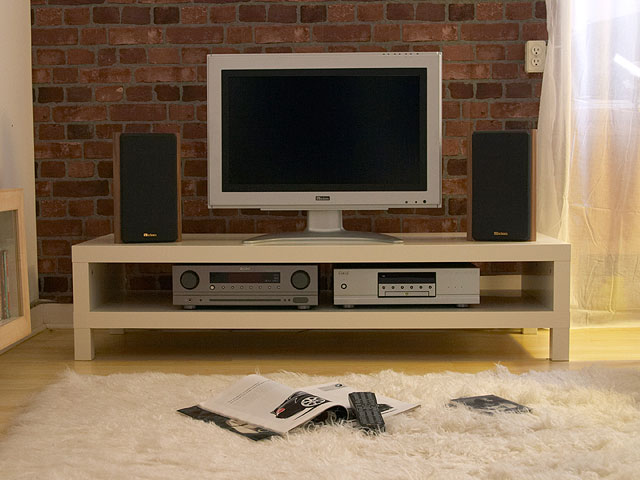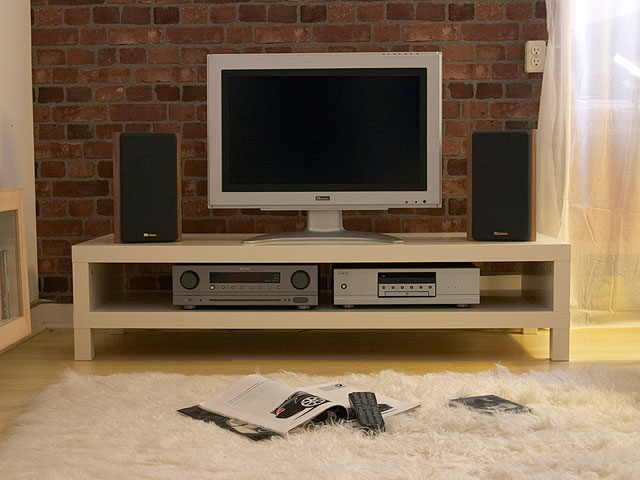Sorting Out the World of DVD Recorders

We know the sounds well: the hushed whirring of a VCR's video heads or its clunky loading and tape-ejection noises. They're familiar and reassuring because those machines have been with us for more than 20 years. The VCR caused a revolution in TV viewing because it enabled us to record and watch TV shows according to our schedule, not that of the TV network. Time-shifting TV shows liberated us from the welter of TV commercials, enabling us to fast-forward through TV ads and station breaks to the next segment of a show. And it let us collect and store family videos as well as favorite TV shows. The VCR also kick-started the trend that led eventually to multichannel home theater movie viewing with image quality and Dolby Digital 5.1-channel surround on DVD that now rival big-screen presentations in commercial cinemas.
Retiring the VCR for a DVD Recorder
Compared to new and relatively unfamiliar devices like a DVD recorder or personal video recorder (PVR; sometimes called a DVR or digital video recorder), a VCR's mechanical noises are comforting. But a VCR's spinning heads and mechanical tape transport inflict edge damage and accumulated wear on videotapes viewed repeatedly, especially archival tapes of family vacations, weddings, children, reunions, and TV shows. Videotape isn't permanent. And VHS picture quality? Ugh. Smeared colors, video noise, and soft, blurry pictures. A VCR's resolution is 240 lines max. Nowadays, we're used to DVD clarity of 480 lines or more, and some of us have already made the move to high-definition TV, with 720 or 1080 lines of resolution. So it's tempting and reasonable to retire that aging VCR and replace it with a stand-alone or set-top DVD recorder/player, the latter often combined with a cable or satellite tuner and a hard-disk drive capable of storing from 15 to 30 hours or more of video. You'll be able to transfer and even edit those family videotapes to a DVD that will last a lot longer than a VHS tape, as well as record TV shows or series to watch at a different time or keep for your library. Compared to VHS, recordable DVDs are capable of stunningly good video quality with an unlimited life span and no deterioration with repeated viewings.
But make no mistake, you won't be able to pop a commercial DVD movie into your player and make copies for your friends or relatives. Commercial DVD movies are all copy-protected, so DVD recorders won't record them. Besides, it's illegal.
The article that follows looks at DVD recorders and PVRs purely as a VCR replacement for video recording, archiving of your personal camcorder tapes, and time-shifting of TV shows. Virtually all these machines contain TV tuners and event timers so you can use them just like a VCR to record and watch programs at convenient times or archive your favorite TV shows.
DVD Recording Formats
You may recall the "war" that occurred between the two mutually incompatible videotape formats when they were first introduced—Sony's Beta versus JVC's VHS (VHS eventually triumphed). Things are somewhat better with DVD recorders but even more complicated: There are five DVD recording formats. The good news is that a fair degree of compatibility exists between your current DVD player and any DVD recordings you may burn (record) on most current DVD recorders. But there are inherent advantages and disadvantages within each format. For instance, Panasonic's DVD-RAM uses a disc inside a cartridge so you don't even touch the disc. And it will play back only on other DVD-RAM recorders from Panasonic and a few other supporters of that format. Because of these and other differences, it's likely the electronics giants will support their particular DVD recorder formats for years, so it's futile to wait for DVD recording formats to resolve to a single universal standard. I wish it were otherwise, but it isn't, so here's a guide to the DVD recording formats and their capabilities. Read this with the warning that any DVD burned in any of these different formats will NOT necessarily play on every DVD player (or computer DVD drive) you may own. It will likely play on some, but not all.
There are three families of DVD recorders, which make them somewhat easier to keep straight. The first pair is DVD-R and DVD-RW, which is the DVD video equivalent to a blank CD-R (write once, non-erasable) and a CD-RW (erasable and rewritable). The next two are DVD+R and DVD+RW (note the + sign). Last is DVD-RAM, which is supported mainly by Panasonic, Toshiba, Hitachi and JVC, who, to varying degrees also support the DVD-R and DVD-RW formats. DVD-RAM is an erasable, rewritable format and is the only one that enables simultaneous recording and playback functions without an accessory hard drive.
Compatibility

Which format will play easily on your current DVD player? That depends. The DVD-R and RW formats are interchangeable, as are the DVD+R and +RW formats. And of course DVD-RAM will only play on other DVD-RAM recorders. It's important to note that DVD-RAM recorders from Hitachi, JVC and Toshiba will also handle the DVD-R and DVD-RW formats. If you own a relatively new DVD player, it will likely play non-erasable write-once DVD-R and DVD+R discs as well as the rewritable and erasable -RW and +RW equivalents. Newer computer DVD-ROM drives will likely play the DVD-R and DVD+R discs. Panasonic DVD-RAM recorders will play only DVD-R and DVD-RAM. They won't record or play DVD-RW.
In order to pick the DVD recording format that's right for you, you'll need to examine how you want to use a DVD recorder's capabilities. If you are a devotee of the new digital camcorder formats (Digital 8 or MiniDV) and you want to be able to transfer and edit video of your vacation trip to a DVD and dub copies for the relatives, check the editing capabilities of the different DVD formats. Most of the DVD recorders enable some rudimentary editing to remove commercials or boring scenes, but if you get a DVD recorder with a built-in hard drive, you'll do most of your recording and editing on the hard drive, using the DVD-recorder capability for the final burn of a permanent DVD. Nevertheless, if doing really sophisticated movie-like editing of camcorder videos is your thing, the general consensus is that you are better off to use a computer with dedicated editing software. And if you want to keep the video in digital form and avoid the degradation that will result in going from digital to analog and back to digital be sure to get a DVD recorder with a FireWire (also called IEEE1394 and i.Link) digital input. If time-shifting of TV programs, even HDTV shows, is important, and you want the ability to record one show while you watch another, then consider a DVD recorder or PVR that's coupled to a hard-disk drive. Some TiVo-like set-top cable and satellite tuner/receiver boxes also offer this capability, and will cache or store HD programs in the original broadcast resolution for later viewing.
If you want to be able to play a recorded DVD on your computer, then it's sensible to choose the same type of DVD recorder as the DVD-burner on your computer. New models of external computer DVD recorder drives will often record on both R/RW and +R/+RW discs, so adding one of these to your computer will also give you more flexibility in picking a stand-alone DVD recorder.
Recording Time vs. Picture Quality
Like a VCR, DVD recorders offer at least three or more different modes similar to VCR speeds, which let you decide on picture quality versus recording time. The very best quality yields one hour per DVD of recording time. Picture quality and resolution is essentially equal to a commercial DVD movie. The worst or slowest mode delivers 6 or 8 hours or recording time per DVD but also picture degradation that may look somewhat better (or worse) than the slowest VCR speeds. According to colleagues of mine in the industry, some DVD recorders deliver picture quality in their 2-hour modes that rivals that of the best 1-hour mode. But using longer than 2-hour modes introduces visible losses in picture resolution and clarity. Because DVD video recording is digital, and uses MPEG-2 encoding, all kinds of pixelation, blocking, noise and other artifacts crop up at the longest recording times.
Keep in mind that no DVD recorder lets you record high-def (HDTV) programs in their original resolution. The DVD recorder will down-convert the HDTV show to standard DVD definition and will record only a Dolby Digital 2-channel stereo soundtrack, not Dolby Digital 5.1. If you get a DVD-recorder/set-top box with a large hard-disk drive that enables HDTV time-shifting, you'd be able to view HDTV shows from the hard drive in their original HD resolution and with Dolby Digital 5.1. The hard drive functions as a cache and stores the video and audio data stream, and so long as the original TV show was broadcast in 5.1 channels you can play it back in that form from the hard drive. But until the advent of HD-DVD recorders, perhaps one or two years away (only prototype high-definition DVD recorder/players have been demonstrated so far), the only way to permanently record and archive HDTV programs in high resolution and there is an amusing irony in this is on a D-VHS digital video recorder that uses videotape! You will need a set-top cable/hard-drive or satellite box with a Firewire (IEEE 1394) output jack to deliver the digital HD signal and the 5.1-channel digital audio stream to the D-VHS VCR.
In the space of this newsletter, it's not possible to cover every variation of DVD recorder and PVR/DVR. But if you know what you want you to do and research carefully, you can find a DVD recorder, PVR, or DVD/hard-drive combo that will do a fine job.






